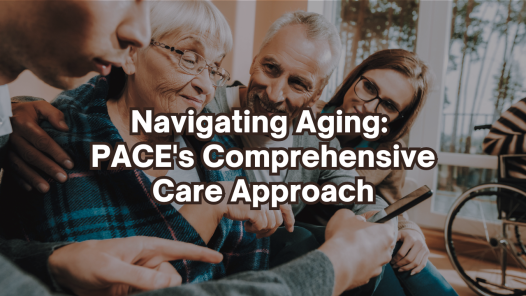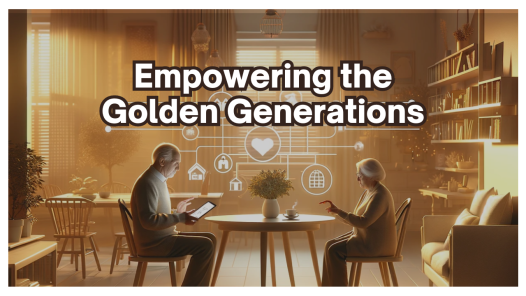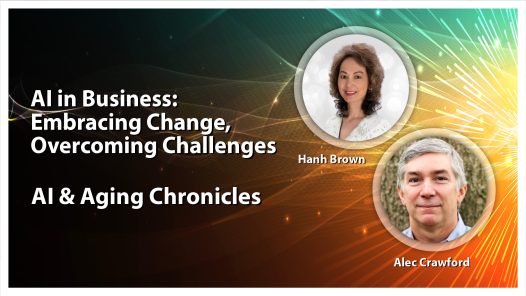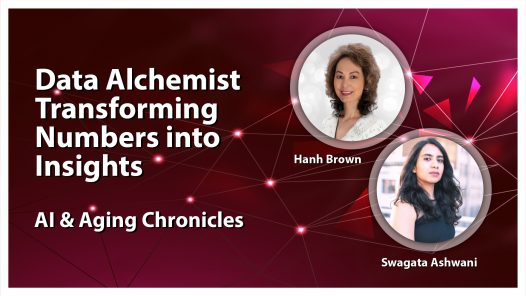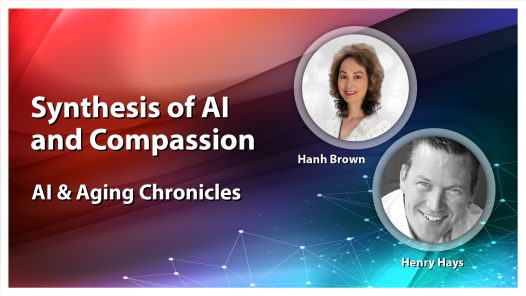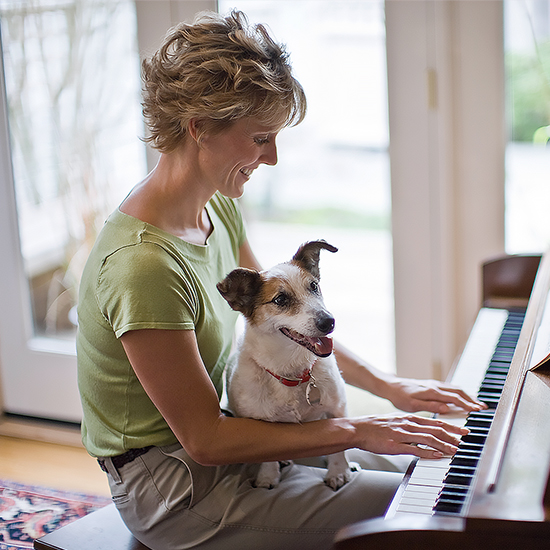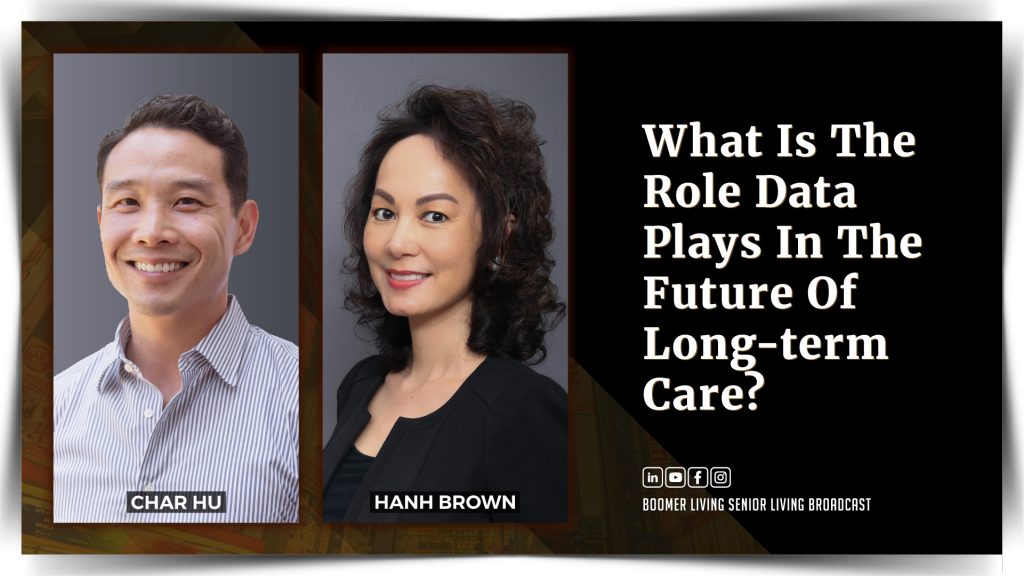
We Believe In Technology’s Ability To Take Data From Other Industries And Provide The Right Size Home Care. Why spend so much money on a caregiver when you don’t need it? You can do activity monitoring or predictive analytics to see what times of day your loved one struggles with certain tasks. Then use the program’s algorithm to predict which days are most likely for these difficulties based on past data before scheduling caregivers in those time slots.
Today I welcome Dr. Char Hu to the program. He’s currently CEO of The Helper Bees, partnering with insurance carriers and health plans to provide the tools for older adults to stay independent, healthy, and at home longer.
We discuss:
- Why Char founded the Helper Bees?
- Aging in America: The impact of a large population of boomers planning to age in place
- A mix of information on payer sources (Long Term Care Insurance & Medicare Advantage) and how they’re leading the charge of innovation in long term care
- The importance of education, resources, and support programs (i.e. Care Concierge)
- The role data plays in the future of Long-term care.
Timestamps:
[00:00] Pre-intro discussion
[01:20] Introduction
[01:53] What was the unmet need that you saw when founding the helper bees?
[03:52] You mentioned your grandmother who was living with Alzheimer was a motivating factor for you in founding helper bee can you talk a little bit, how has this personal experience with Alzheimer’s impacted you or motivated you personally and professionally?
[05:55] Do you often keep your own grandmother in mind when working and helping families and their search for quality in-home care?
[10:27] Let’s take a step back and talk about the state of American aging and what will the impact of this large population of boomers planning to age in place? What do you think that’s going to happen?
[12:50] How does this look different from how previous generations have chosen to age? How do you think this demand shift will impact the senior living industry as a whole?
[14:26] How does having a mix of payer sources like long-term care insurance and Medicare Advantage lead the change in innovation in long-term care?
[16:45] How important is the role of education, resources, and support programs when choosing a long-term care option for yourself or for your loved one?
[18:02] What do you think the role data plays in the future of long-term care?
[19:59] Where are you on this journey?
[20:55] Walk me through, let’s say I’m 80 years old living at home. Walk me through the process. How Helper Bees can help me stay at home longer or defer the time that I would have to move into assisted living?
[23:16] In general, where do you think the long-term care industry will go in the next 20 years?
[24:18] Do you have any other thoughts that you would like to share?
[26:14] Wrap-up
Bio:
Char Hu, PhD
CEO at The Helper Bees
After completing his doctorate at Baylor College of Medicine, Char translated his biomedical research experience into Alzheimer’s and dementia care, founding and directing a certified dementia community. He’s currently CEO of The Helper Bees, partnering with insurance carriers and health plans to provide the tools for older adults to stay independent, healthy, and at home longer.
As a founder and director of Georgetown Living, a certified dementia communities, he is actively involved in supporting the needs of Central Texas’ older adult community.
Today, Char brings his passion and industry experience to his mission of transforming in-home older adult care. When not tending his hive as CEO at The Helper Bees, Char spends his free time working with local nonprofits focused on issues related to aging, and serving on the boards of directors at AustinUp and Alzheimer’s Texas.
Learn more about Char and his company here:
LinkedIn: LinkedIn: https://www.linkedin.com/in/charhu/
The Helper Bees: https://www.thehelperbees.com/
Transcript:
Char Hu: 0:00
Payer sources, it was well, it’s really expensive. It’s expensive for me as a private individual, it’s also expensive for large insurance carriers, but it’s also very expensive to us as citizens because Medicaid is the largest provider of long term care support services. And so we wanted to build the company, the helper bees around how do we deliver a scalable model, not only to individuals and older adults, but also the payer sources to help us from a societal benefit. How do we reduce that burden? That financial burden. That’s the power of scale and that’s the power of technology. Hey, how are you?
Hanh: 1:13
Good. How are you?
Char Hu: 1:14
Nice to meet you in person?
Hanh: 1:16
Good to meet you.
Char Hu: 1:17
I know we’ve, we got connected a while back. So happy to be here.
Hanh: 1:20
Okay. Well today I welcome Dr. Char Hu to the program after completing his doctorate at Baylor College of Medicine. Sure translate his biomedical research experience into Alzheimer and dementia care founding and directing the certified dementia community. He’s currently the CEO of the Helper Bees partnering with insurance carriers and health plans to provide the tools for older adults to stay independent, healthy, and longer at home. Char, welcome to Boomer Living.
Char Hu: 1:51
I’m excited to be here. Finally.
Hanh: 1:53
Yeah. What was the unmet need that you saw when founding the helper bees?
Char Hu: 1:59
As you mentioned, translated out of science Alzheimer’s care delivery and senior living facilities because of my grandmother. We would always, we built fantastic facilities. It’s North of Boston Austin, Texas, and L evidence-based focus, boutique type atmosphere, but families routinely would come out and say, I wish I never met you. So they would say, even though we have this wonderful facility would say something along the lines of wish we never met, you wish we never had to move in. And that was just because the home care options just weren’t suitable for them to keep their loved one at home. They were also commenting on the disease, of course, but also just the care types. And there will always be a place for senior living facilities because it just stretches both budget as well as primary caregivers for stress levels. But to the unmet need for our founding team, we realized that there’s no really great, scalable way to create home care in a modern approach. Home care. In my mind, hasn’t changed in decades and decades. And so we were thinking, Hey, we’re having a massive boom in not only aging in place technology, but technology in general technology and the way we think about different business models, as well as hardware and software. How do you marry all of these things together and create something that. Might delay the need for a facility and we’re not trying to prevent it completely, but just delay and keep people at home. So that was one huge unmet need. The second though, which is, he mentioned it in the bio is around payer sources. It was well, it’s really expensive. It’s expensive for me as a private individual, it’s also expensive for large insurance carriers, but it’s also very expensive to us as citizens because Medicaid is the largest provider of long term care support services. And so we wanted to build the company, the helper bees around how do we deliver a scalable model, not only to individuals and older adults, but also the payer sources to help us from a societal benefit. How do we reduce that burden? That financial burden. That’s the power of scale and that’s the power of technology.
Hanh: 3:51
That’s awesome. You mentioned your grandmother who was living with Alzheimer was a motivating factor for you in founding helper bee can you talk a little bit, how this personal experience with Alzheimer impacted you or motivated you personally and professionally?
Char Hu: 4:07
Yeah. Yeah. It completely motivated me professional. I have a complete career now that I’d never thought I would have gone into which a lot of people in long-term care. Like we have a lot of us when you see the people who are very passionate about it had a very visceral personal experience. Mine was my pawpaw, which was my mother’s mother. She wished like a lot of folks probably started showing signs when I was in undergrad. But really didn’t come to really hit us in the face hard until my graduate school years. And I remember having to quote-unquote babysit, which was just every evening, one of my sisters, or I would spend an hour with her and just sitting and talking and she would replay a lot of historical issues that might’ve happened. Might’ve misremembered certain things, but my family is of Chinese descent. I was born here, but my parents immigrated here and there’s a sort of stereotype around East Asian cultures that we take care of our own. We would never go to a facility it turns out we had to it just became so challenging for our family that you would literally have to have one other human being, watching that individual and that guilt that just that again, that this real family experience stay with my mom for many years. And they had a raid retired, but they decided, Hey, let’s fund something that makes this a little bit better. And I was the kid out of school. I went to college at 16. I went straight into undergrad sorry, a new graduate school. And I came on early on just to try to help out a little. Cause my mom said I had no real practical, real world experience, which she was right. And it’s hard not to fall in love with the area. And it is hard not to fall in love with the unmet many unmet needs out there. And if you’re a problem solver, you’ll see a lot of problems to solve and you’ll start a lot of companies. So I found it three or four different companies after that and, or had a founding role in it rather. And yeah, led me on a career. I would, again, never thought I would have gone down.
Hanh: 5:52
Yeah. Yeah. That’s awesome. Congratulation. So do you often keep your own grandmother in mind when working and helping families and their search for quality in home care?
Char Hu: 6:02
It’s an interesting question because there’s so much I do, but it’s probably not in the obvious way behind it. When I focused on dementia care, my grandmother was difficult for us. Even as a scientist, I didn’t understand the disease. Within the first month I realized my grandmother was actually on the acuity spectrum and senior living. One of the more independent ones. There’s very challenging individuals. So in that sense, I do keep her in mind in that while we had no idea how challenging this disease can be. Like we felt we had it bad. This is really challenging. Especially when you get into sort of three more. Behavioral disturbances that my grandmother didn’t have physical outbursts. So I keep her in mind and I’m like, wow, that’s, this is a lot more challenging. This is how bad it was for us. I cannot imagine how it is for this family. Let’s run towards that problem. Let’s try to fix it. It’s real. Quote, unquote, fix it on the helper bees side I do because there’s there so early in the journey and we didn’t reach out for help. We grid impaired it until let’s do a breaking point, which is something that I know that you have a lot of folks talk about. And I think about that and how, whenever I close any talk, when I talk to any caregivers, reach out for help soon. Cause, cause we didn’t. Like we didn’t that the one, right? It’s the perverse one good thing about these aging related issues, especially something like dementia is, where it’s gonna go. You know the progression. So you might as well be prepared. So I keep that in mind a lot is like, how do we prepare people? Because we’re guides because we’ve been there before we’ve done it thousands of times now. And I believe it’s our job to show them where the pitfalls are and where the light could be.
Hanh: 7:35
I think it’s such a culture shift though, right? Because I think often. Think of the word decline, especially when it’s cognitive decline, it’s very frowned upon and it’s group into like perhaps even shameful, which we need to shift that. Okay. And then I think often we think of the word let’s say later years is to be very glamorous. It’s retirement. That is glamorous. But under that huge umbrella of retirement, let’s say mid eighties and ban well as you and I know it may not be glamorous. So we’re just caught up in the glamor whatever that might be in feel ashamed of aging and the decline of health. And I think that has a lot to do with Hollywood. You and I, and the folks in the industry, boy, I’ll tell you, we got a huge paradigm shift that I think we all can play a role in.
Char Hu: 8:28
Yeah. I have a theory around that I think aging is relatively new for us as humanity. Aging, as we know it if we look at life expectancy charts, like we are in this, it’s unprecedented us living this long and this healthy quote unquote healthy. And so that’s why we have age-related illnesses now because we’re living old enough to start to have these. And so for us as humanity is this relatively new problem for us to wrestle. Even when I got in this a little over 11 years ago, there was a significant amount of shame. Caregiver support groups were a thing, it wasn’t well attended the sheer terribleness of the problem. The sheer scale of the problem means most of us now have had a direct interaction with it, which helps bring that shame out where it’s now you and I can connect on a shared experience. It’s a terrible, shared experience, but we can connect on it and we can connect up to a thousands of other individuals. I think that causes us to be able to have to shine a light on it. And also look at new solutions like you mentioned, like even. This, the fact that we’re even talking about it, I think is a remarkable shift you mentioned a paradigm shift. It’s an indicator that it’s occurred and it’s happening at an accelerated rate. And we’re starting to think about it in a different way. And looking as we’re romanticizing aging or being ashamed of aging. And that’s because people like you are having the conversation, but it’s relatively new. So I don’t want to be too hard on ourselves. This is a one, maybe two generations that have had to deal with this.
Hanh: 9:56
Yeah, I agree with you. I think The journey that we’re on is still very new because folks who are, let’s say in the mid fifties, that I am by no means, do I feel like in my fifties, and certainly folks who are 30 years ago that were in their mid fifties and where I’m at right now, very vastly different. And what a blessing is that. So that paradigm shift is overdue and we got to amplify it, especially COVID. And I think we have the attention from the media. So let’s go and let’s do it as much needed. Yeah. So now let’s take a step back and talk about the state of American aging and what will the impact of this large population of boomers planning to age in place? So what do you think that’s going to happen?
Char Hu: 10:40
Huge question. So I’ll give my tiny point of view and perception active on it.
Hanh: 10:44
Okay.
Char Hu: 10:44
So I’m interesting in the senior living world, because I’m a senior living guy, like just cut my teeth in that. And absolutely loved the industry. Now it’s a home care person. And I think the move to the home is where everybody wants to be. I think COVID has really opened our eyes to some of the limitations of facilities. Although again, I think they’re critically important to our healthcare system and I’ll use that word healthcare system as well as our age-related illness system. I think that with home care, though, we have this swelling of innovation. The issue is who can afford it, who can afford the age in place. Now let’s say we have the coolest new technologies figuring out who pays for and how we pay for it and how we start to plan for it is something that I think we’ve been spending a lot of time thinking about where as you mentioned, it’s not a problem. That’s 50, 60 years out. That’ll still be a problem, but it’s one today and it’s just getting worse. So it’s the need is significant. So we believe technology and data taking from other industries, the ability to use technology and data to do. What’s what we’ll think of like right care, right? Size, home care. Does everybody need eight hours, seven days a week of home care? Probably not. It’s very expensive. But if you could do, let’s say like activity monitoring or sort of predictive analytics to say you have these activities of daily living you’d really need support with, at these times, let’s use a caregiver three hours in the morning and two hours at night, then we’re able to reduce that rate and that allows it to become a little bit more affordable. So that’s all to say that when we marry technology and humans and decide how we get. Great caregivers. Great paid caregivers into the home at scale. I think that is a term that we’ll need in order to a pent up consumer demand is here. That’s what you want, and they’re going to want a better user experience. And I believe in all other facets of our lives, where we use technology and data and accessibility, we’re going to want that with our home care solution. So that’s a narrow view of where we’re going to go to meet this massive demand. It’s gotta be our home. That’s the only way we can’t build a tons of these independent living facilities and they can be quite expensive for a lot of Americans.
Hanh: 12:47
Sure. Sure. I wholeheartedly believe that. So now, how does this look different from how previous generations have chosen to age? How do you think this demand shift will impact the senior living industry as a whole?
Char Hu: 12:59
I think in a couple of ways, just because I view from a data perspective, I think they were more open to technology. I think even during the pandemic we saw, we did a lot of virtual technologies. And I think that individuals from all the way up to 90 are a lot more comfortable with technology. A lot more comfortable with video technology. You got to make it seamless. You gotta make it easy to use. I think that’s a big change that occurred over the last 14 months that probably didn’t exist at scale beforehand. And I think that opens up a lot of windows from social isolation to depression, to telemedicine. Of course we do tell the nursing services. So that’s one area. And I think if you zoom out though, the broader implication is that. Then user is, are open to different things. We’re all also perhaps a little bit more open to sharing our information. If we get something really interesting back that we’ve learned from social networks, that, yeah, they’re going to use our user behavior data, but they’re going to give us really tailored. Products that could, that we have the choice on whether we want to purchase or not. I think if we twist that a little bit or are skewed a little bit, I think you might have that with like remote patient monitoring devices or activity monitoring devices or wander guards. They weren’t even a lot more comfortable using these technologies as we start to age. So I think this population, our population now is really different from what it was a generation ago, because they’re just more comfortable with adopting new things and giving things to try to.
Hanh: 14:17
Yeah. Yeah, I agree. My mom and dad were very open to using technologies and sometimes they had the latest, greatest technologies before I did. Now, how does having a mix of payer sources like long-term care insurance and Medicare advantage lead the change in innovation in long-term care?
Char Hu: 14:37
Yeah. So I have a weird business wonky approach to thinking about this. I think about infidus for change. I think about what is a catalyst. I think we, as an individual consumer base, so private pay people, which as is predominantly who pays for long-term care, Medicare doesn’t cover it. Which most people think it does we don’t have the lobbying power to, in my mind to really force demand. And I think it’s because of how expensive care is. But when we look at who has what I’ll key column, let the liabilities who has the risk that’s payer sources, especially long-term care insurance, which had issued quite a few policies in early 2000 and now those policies are coming. Coming due essentially. And their actuarial assumptions were all shot. They have a lot of money, billions and billions of dollars. They’ve got the impetus to change. They’ve got the scale to change and they got the funds to say, Hey what could work? And I think that’s where we’re going to see a lot of innovation we already have where. Big long-term care. Insurance companies are starting to figure out, Hey, this is a 2030 year problem that we’re on the hook for. We have money now let’s invest in it now. And let’s cobble together a bunch of different data sources and we have a lot of different claimants out there and we can study them. So borrowing from a science research days, you have the sample to study, whereas recruiting all the individuals out there is going to be really challenging. So in a weird way, I think it’s the perfect sandbox to deploy things. I use the example of a big long-term care insurance carrier, wanting to deploy a caregiving robot they could do it very quickly and they could analyze the effect 12 to 24 months. And so I’ve seen a lot of innovation, some with our companies and some with others within the long-term care insurance world that I think are going to impact the broader aging, especially in the home, but also in the facility world. For all Americans and then I’ll layer on that Medicare advantage. It’s a relatively new program. It’s only about a year or two old, and it’s still pretty small benefit, but I think you’ll see the same. I think you’ll start to see how do we bring in things like meal delivery, transportation services, home modification, which we’re all helping Medicare Advantage plans right today, coordinate those services. How does that affect aging at home? And that’s where I think they have this accumulation of data source to say, does it working or does it not working?
Hanh: 16:45
How important is the role of education, resources and support programs when choosing long-term care option for yourself or for your loved one?
Char Hu: 16:53
I think it’s critical. I think what we were talking about earlier about this becoming us, knowing every person around us is going to have this issue. I think now we get to share information. We get to share what worked, what didn’t work. We want to go research on our own. I use the example. When I buy a power cord from my phone, from my iPhone, I’m reading Amazon reviews. And I’m spending $6 on a cord. What about my care options? There’s a lot of disparate information out there, and it’s a shocking amount of lack of research that we do as consumers. But I think that’s changing. I think people now are like, all right, what’s out there and is this it? And I think that will lead into a lot of innovation. A lot of folks just want to read on their own, even older adults. You mentioned like your parents who are really tech savvy, they’re gathering a ton of information on their own conditions. They’re seeing. What else is out there from a home modification perspective. Let me go research all of that. So I think in order to allow this to become at all, economically feasible for us as a society is we take a little bit of that ownership. And that’s the education. This either through prevention, that for things like falls or medication management issues, but also how do we future proofing our home? Let’s think about this 10 years away. And that’s only through learning through case studies that preceded us.
Hanh: 18:02
So what do you think the role data plays in the future of long-term care?
Char Hu: 18:06
This is something we’re incredibly passionate about. I alluded to it before, who has the impetus to change? Who has the risk? If we really identify why that matters is there is a data model, a data profile, how to age in America. That’s really important concept what interventions work. We always talk about fall monitors, med adherence devices, social isolation, but who has the data that support this intervention package actually works. For thousands or millions of people. The problem with getting that data is home care options. And I’m talking about non-medical options are highly fragmented, meaning it’s I hire a private caregiver myself, or I use a home care agency, but that home care agencies data is not talking to this other, the aggregators of all this data tend to be insurance, payer sources, because you got to get paid. You got to submit for reimbursement. And so what’s interesting about that is if you put things like caregiving and nursing and social work on the same data platform, a picture emerges of how individuals start to migrate through their aging journey. What you have to do is create the common language to come a profile for that, so that you can extract really interesting information for you as an individual, based on your zip code, your gender, your age, your diagnoses, but also your social determines of health information. That’s how we’re going to be able to say. Hey Char this is the thing you need. These are the three devices that you need based on your profile. And so what we’re trying to do is create the common language for all non-medical home care, to extract that information, which we’ll call a data profile. I like to use the analog of electronic medical records, where it’s a bit of a mess right now. You’ve got a bunch of different vendors, not every physician’s office is using the same service, but what if we could go back 60 years and say, Hey, let’s streamline this. Let’s create a common language that how powerful that could have been. I believe we’re at the cusp of that right now.
Hanh: 19:59
Where are you in this journey?
Char Hu: 20:00
I think we’re one of the few, we’re not the only, but we’re one of the few that’s putting all what I’ll call major components of non-medical home care on the same data platform. We did that as a young company, we made a big stride towards that. And what’s really interesting is those seeds that we planted, which is pretty complicated or able to now we’re starting to see them slightly germinate and start to see really interesting interventions because aging is such a long issue. We got a bunch of data early on. Let’s say, when you’re starting to you starting to show a little bit of debilitation every single day, we have visit notes and 12 data points, and then we have intervention data points. So it’s still early, but I’m very optimistic. I even have like a bombastic statement that I think our company will understand aging in America, better than almost anybody from a data perspective in about 12 months.
Hanh: 20:45
Great. Great. Look forward to learning more about that.
Char Hu: 20:48
We’ll see if I’m right. We’re trying, at least we’re trying, it’s good to shoot for the moon. So that’s our goal.
Hanh: 20:54
Absolutely. Okay. So I’m going to ask you to walk me through, let’s say I’m 80 years old living at home. Walk me through the process. How helper bee can help me stay at home longer or defer the time that I would have to move into assisted living.
Char Hu: 21:11
Sure. So think about that user journey. I think it starts right now with the program we call care concierge a care concierge program is exactly as it sounds like when we used to be able to visit hotels somewhat, I have a concierge who understands the local resources and it just accelerates that says, Hey, I know this restaurant, or I know this guy over here, we do that same with the care concierge. It’s very similar care management programs that post acute healthcare has, except we focus specifically on age-related issues. So our care concierge will talk to you or an 80 year old and say, Hey, what’s, what are your challenges? Tell me what’s going on during your day. Those 80 year olds don’t have a care plan in mind, so they’re not going to tick off. Oh, I have an ambulation difficulty and I need a hands on assist in the bathroom. So you’re just having a dialogue. And what we’re doing is assessing the individual’s needs. During that assessment, we might be able to find out like, Oh, you’re really you weren’t able to get out and go to an art class. So part of your action plan might be to have social activities via zoom or something like that, or an iPad app or physical therapy. We break up into big categories of needs, which is around physical needs, social needs, financial needs, and that’s the start we call them action plans. So we say, what are the unmet needs? What are the action plans locally that you can take? And we send that to you. A lot of time that’s around home care support services. And so then we funnel that to another part of the company where we use personality based matching of home caregivers. We also have a network of eight home care agencies that have reduced rates. And what we’re trying to do is match you with a great service provider. That’s either a private agency or a private individual that’s at a lower cost, and we can negotiate better rates because we have scale. And that might be it, but Hey, I need right sized care and we helped negotiate and create a care plan or it could be, Hey, I need a nurse to do a consultation and we can do that over video. Or I need to go to the loop and have a virtual walk through the loop cause I miss art and I miss interaction. So it’s a huge spectrum of needs. And then we present that and then we follow up routinely. It could be monthly, it could be every two weeks. It could ever be every 60 days and just track that progress. And. We see how that evolves over time. We have a structured data set to make sure that we’re tracking you properly and we can pull out that data later.
Hanh: 23:13
You’re nationwide. I take it. Right. Okay, So now in general, where do you think long-term care industry will go in the next 20 years?
Char Hu: 23:22
I think that there’s going to be a huge adoption of technology in general, in both in facility-based care and home-based care. And I think you’re going to start to see a blending between that ease of transition to home to facility. I think you’ll start to see before we were on opposite ends. I think in a few years, you’re going to start to see a little bit of a melding and I keep talking about user experience and I use that because that’s just how we think about the world is as you navigate through age-related issue, it’ll be pretty seamless. You’ll know what’s coming and you’ll know what your care options are. And that’s partly senior living folks in home care folks blending their offering and having what we’ll call continuity of care. But that’s part and parcel with education piece that you had mentioned. I think all our consumers are going to, they’re going to know what they want and they’re going to know really what they don’t want. And they’re going to be demanding. It’s going to force us as business operators and innovators to change pretty quickly to meet that demand. So I think the power of the purchasing power is going to be really interesting. You’re going to see in full force starting now.
Hanh: 24:17
Great. Great. So do you have any other thoughts that you would like to share?
Char Hu: 24:21
I think, you’ve got a wide audience. I’ll use what I always close with. We own educational seminars when I’m not talking about broadly data. I think it’s get prepared to talk to a lot of folks seek help. There’s no shame in this. We’re all going to do it. If we’re lucky, we’re all going to go through this. And I think there’s a power in talking about it and seeking guidance for others who have been there or other professionals out there because at least to an insanely high quality of life.
Hanh: 24:44
I agree. I think at the very least whatever age that you’re in, perhaps you could be the daughter who are in their fifties, mid fifties like I am start having that conversation with your parents and walk them through that journey because you know what it’s really, I believe information is widely available, but it’s making that decision and convincing your parents that it’s time. And then accepting this journey that as a family, it’s not just individuals, it’s a whole family, And the more United educated they are likely to make better decisions, whether it’s in-home out of the home. I think the goal is to live at whatever age, whatever health condition that you’re in to the fullest. Thrive and with purpose.
Char Hu: 25:32
Yeah, absolutely. And the more you talk about it, the more it normalizes it and it makes it more of a normal conversation. In a way you get to choose your own destiny. So people believe facilities are a lack of choice. I don’t think it is. I think that if you don’t do anything, you will be forced into an option because you would likely waited too long. So if you flip it, if you start planning and talking about it, that’s when your desires are expressed and you can make, if this happens, Then I’m going to do this. And I think that’s an important area for choice. And that’s a huge component. That’s one of the taglines of our company, which is your home, your choice. We’re built around individuals choosing their own options, and we’re just here to guide you towards them. If it’s us great. If it’s somebody else also great, but make an educated decision and make it four eyes wider.
Hanh: 26:14
You’re right about that. I love that analogy. The sooner you start, you have more options. The later you go into it, then exactly. Perhaps you might be forced into something that you don’t want. So very good analogy. I thank you so much for this opportunity to talk.
Char Hu: 26:29
For sure. And if there’s anything we can help support, we can, and yeah we’ll definitely share it and try to get that exposure for both of us.
Hanh: 26:37
Great. All right. I thank you for your time.
Char Hu: 26:40
Thanks. It was fun.
Hanh: 26:41
All right. Take care. Bye bye.





